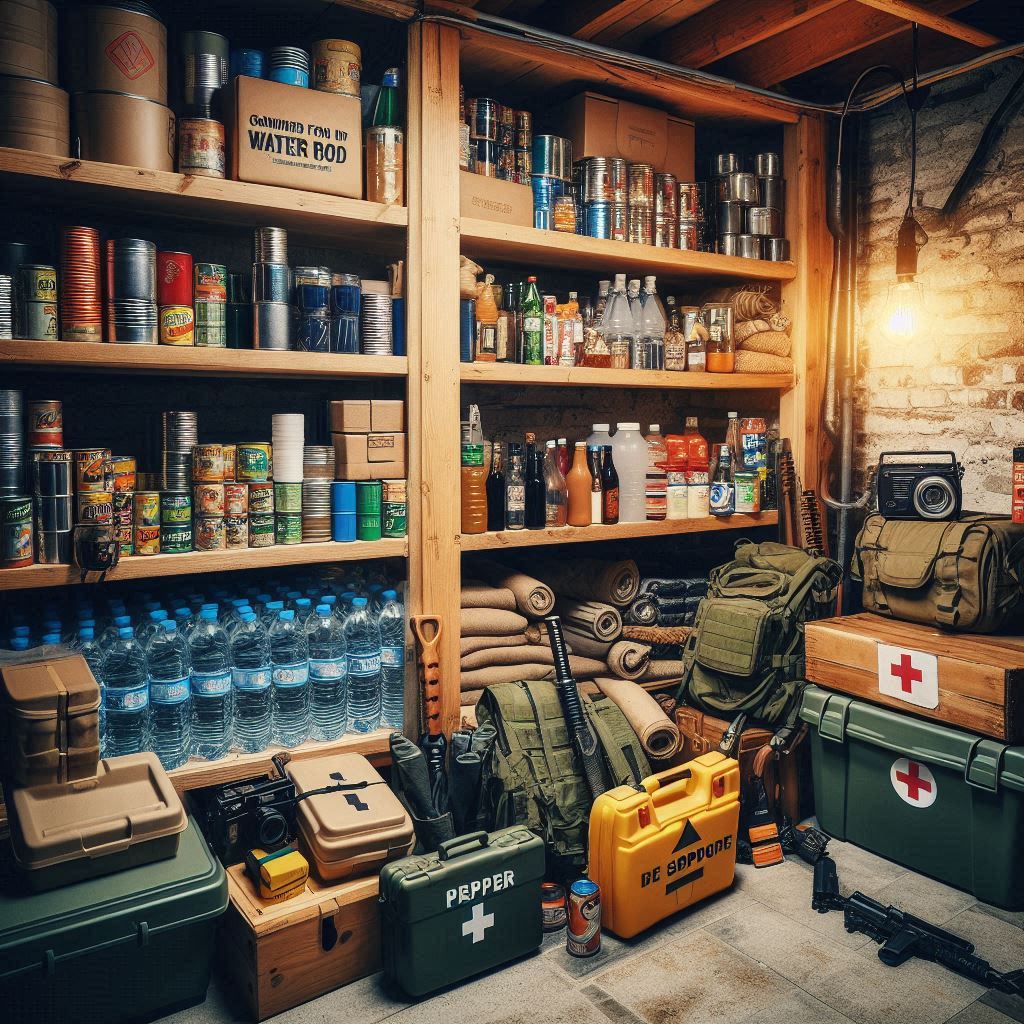Disasters, whether natural or man-made, can strike unexpectedly and disrupt daily life in significant ways. Natural disasters such as earthquakes, hurricanes, floods, and wildfires can cause widespread damage, while man-made events like industrial accidents, terrorism, and civil unrest can create equally chaotic and dangerous situations. The impact of these events can range from temporary inconveniences to life-threatening emergencies, making it essential to have a well-thought-out preparedness plan in place. Being prepared not only helps ensure your safety and that of your loved ones but also reduces the stress and confusion that typically accompany such crises.
This comprehensive guide outlines the essential steps and resources needed to be adequately prepared for any disaster and increase your chances of survival. It covers everything from assembling a robust emergency supplies kit to developing effective communication plans and learning crucial survival skills. By following the guidelines provided, you can create a preparedness strategy tailored to your specific needs and circumstances. Additionally, fostering strong community connections and participating in local preparedness initiatives can enhance your ability to respond effectively when disaster strikes. Ultimately, proactive planning and readiness can make a significant difference in navigating and overcoming the challenges posed by unexpected emergencies.
1. Emergency Supplies Kit
- Assemble an emergency supplies kit by including at least a three-day supply of water, non-perishable food items such as canned goods and protein bars, and essential first aid supplies like bandages, antiseptic wipes, and pain relievers. Ensure you have multiple flashlights with extra batteries to provide reliable lighting during power outages, and consider including a multi-tool that offers various functions like cutting, opening cans, and making minor repairs. Additionally, include other critical items such as a whistle for signaling, a battery-powered or hand-crank radio for emergency updates, and personal hygiene items to maintain health and cleanliness.
- Stockpile at least a three-day supply of food and water per person, ensuring each individual has one gallon of water per day for drinking and sanitation. Select non-perishable food items that cater to any special dietary needs within your household, such as gluten-free or low-sodium options, and consider the specific nutritional requirements of infants or elderly family members. Don’t forget to include an adequate supply of pet food and water for your pets, along with any necessary medications or special items they may need to stay comfortable and healthy during an emergency.
- Include essential items for personal hygiene, such as toothbrushes, toothpaste, soap, shampoo, and deodorant to maintain cleanliness and comfort during an emergency. Add sanitation supplies like disinfectant wipes, hand sanitizer, garbage bags, and plastic ties to ensure proper waste management and reduce the risk of illness. Make sure to pack any necessary medications, including prescriptions, over-the-counter drugs, and any specific medical supplies, such as inhalers or insulin, to manage health conditions effectively during a crisis.
2. Communication Plan
- Develop a comprehensive communication plan with family or household members that includes designated meeting points both within and outside your immediate neighborhood to ensure everyone can reunite safely if separated during a disaster. Compile a list of emergency contacts, such as relatives, friends, and local emergency services, and ensure everyone in the household has a copy stored in their phone or written down. Establish reliable methods for staying in touch, such as using text messages, social media, or a predetermined out-of-town contact person who can relay information and provide updates on each family member’s status and location.
- Make sure all family members are familiar with using cell phones, including texting, making calls, and accessing emergency contact information, as well as operating walkie-talkies or other communication devices you may have on hand. Conduct regular practice sessions to ensure everyone, including children, can use these devices efficiently and understand essential features like setting up group calls or sending SOS signals. Prepare a backup plan in case traditional communication methods fail, such as establishing a predetermined meeting spot, using written messages left in a secure location, or employing a battery-powered or hand-crank radio to stay informed and coordinate with emergency services.
- Stay informed about local emergency alerts and evacuation procedures by regularly monitoring official channels such as FEMA’s website, your local government’s emergency management page, and subscribing to alert services that send notifications directly to your phone. Familiarize yourself with the types of alerts you might receive, such as severe weather warnings, evacuation orders, or shelter-in-place directives, and understand the recommended actions for each scenario. Additionally, keep an emergency radio on hand, preferably one that is battery-powered or hand-crank, to receive continuous updates and instructions if internet or cellular services are disrupted during a crisis.
3. Shelter and Clothing
- Prepare your home for potential disasters by reinforcing windows with storm shutters or impact-resistant glass to protect against high winds and flying debris. Secure loose objects both inside and outside your home, such as securing bookshelves to walls, anchoring heavy furniture, and storing outdoor items like patio furniture or garden tools that could become projectiles during a storm. Identify and designate safe areas within your home, such as a basement, interior room, or a small, windowless space on the lowest floor, where you and your family can take shelter during extreme weather events like tornadoes or hurricanes.
- Ensure you have appropriate clothing and footwear for all weather conditions by including items such as thermal underwear, sweaters, and waterproof jackets to provide warmth and protection against cold and wet conditions. Prepare for hazardous environments by having sturdy, slip-resistant boots, gloves, and hats to protect against debris, sharp objects, and extreme temperatures. Additionally, pack protective gear like masks and goggles to shield against smoke, dust, or chemical exposure, ensuring everyone in your household is equipped to handle a variety of emergency situations safely.
- Consider alternative shelter options in case your home becomes uninhabitable by including durable tents and waterproof tarps in your emergency kit to provide temporary protection from the elements. Research and identify nearby emergency shelters operated by local authorities or organizations like the Red Cross, and familiarize yourself with their locations and entry requirements. Additionally, keep portable sleeping bags, blankets, and basic camping supplies handy to ensure you can maintain some level of comfort and safety while waiting for more permanent assistance or shelter arrangements.
4. Emergency Plans
- Create detailed emergency plans for various scenarios, outlining clear evacuation routes from each room in your home and identifying multiple exits to use in case primary paths are blocked. Develop shelter-in-place procedures, designating specific safe areas within your home where you can stay during events like severe storms or hazardous material incidents, and ensure these areas are stocked with essential supplies. Additionally, establish specific response actions for different hazards, such as practicing fire drills to ensure everyone knows how to escape quickly, and preparing flood response steps, like moving valuables to higher ground and turning off utilities to prevent water damage and electrical hazards.
- Conduct regular practice drills with family or household members to ensure everyone is familiar with emergency procedures and can evacuate safely if necessary. During these drills, simulate different scenarios such as fires, earthquakes, or severe weather, and practice evacuating from various rooms, using both primary and secondary escape routes. Review and reinforce the importance of staying calm, quickly gathering essential supplies, and meeting at a predetermined safe location outside the home, ensuring that even young children understand and remember these critical steps.
- When developing emergency plans, consider the specific needs of vulnerable populations such as children, elderly individuals, and people with disabilities by ensuring that evacuation routes are accessible and free of obstacles. Prepare additional supplies tailored to these groups, such as medications, mobility aids, and comfort items for children, and designate a caregiver responsible for assisting them during an emergency. Additionally, create a communication strategy that includes methods to keep these individuals calm and informed, and ensure that everyone understands their roles in supporting and protecting the most vulnerable members of your household.
5. Survival Skills and Training
- Acquire basic survival skills to increase your preparedness for emergency situations by taking courses in first aid and CPR, ensuring you can provide immediate medical assistance and potentially save lives. Learn fire safety techniques, including how to use a fire extinguisher, create a fire break, and safely evacuate a burning building, to protect yourself and others during a fire. Additionally, educate yourself on how to purify water using methods like boiling, filtration, or chemical treatments, and develop foraging skills to identify edible plants and resources in your environment, providing vital sustenance if traditional food and water supplies are unavailable.
- Enroll in specialized training courses tailored to the specific hazards prevalent in your area to enhance your readiness and response capabilities. For example, take earthquake preparedness classes that teach you how to secure your home, create an emergency kit, and safely evacuate or take shelter during tremors. Consider wilderness survival training if you live near forests or remote areas, learning essential skills such as building shelters, navigating without a map, and sourcing food and water, or participate in urban search and rescue courses to acquire techniques for locating and assisting individuals trapped in debris following disasters like building collapses or explosions.
- Maintain physical fitness to ensure you have the strength, endurance, and agility needed to respond effectively in a disaster, whether it involves evacuating quickly, carrying supplies, or assisting others. Build mental resilience by practicing stress management techniques such as mindfulness, meditation, and deep-breathing exercises, enabling you to stay calm and make clear decisions under pressure. Foster adaptability by regularly challenging yourself with new and unexpected tasks or scenarios, which helps develop problem-solving skills and the ability to remain flexible in the face of changing and adverse conditions.
6. Financial and Legal Documents
- Safeguard critical documents like identification cards, insurance policies, medical records, and legal documents by storing them in a secure, waterproof container to protect them from damage during a disaster. Include copies of birth certificates, passports, social security cards, and financial records, ensuring these vital papers are easily accessible and organized for quick retrieval if you need to evacuate. Consider using a fireproof safe or a durable, sealable plastic bag to provide additional protection, and keep digital copies on a secure, encrypted cloud service or an external hard drive as a backup.
- Store copies of these essential documents in a secure location outside your home to ensure you have access to them if your primary copies are lost or damaged. Consider using a bank safety deposit box, which offers high security and protection against fire and water damage, to store duplicates of important papers such as identification, insurance policies, and legal documents. Alternatively, entrust copies to a reliable relative or friend, ensuring they understand the importance of keeping these documents safe and accessible for you in case of an emergency.
- Establish and maintain a financial emergency fund to ensure you can cover unexpected expenses that may arise during and after a disaster, such as temporary lodging, home repairs, and replacement of essential items. Aim to save enough to support your household for at least three to six months, keeping these funds in an easily accessible account, like a savings account, so you can quickly access the money when needed. Regularly review and adjust your emergency fund to account for inflation, changes in living expenses, and any specific risks associated with your location, ensuring you are financially prepared for a wide range of potential scenarios.
7. Community and Mutual Aid
- Build strong relationships with neighbors by organizing regular community meetings, social events, and emergency preparedness drills to ensure everyone knows each other and can offer mutual support during a disaster. Engage with local community organizations, such as neighborhood watch groups and volunteer fire departments, to stay informed about local resources and initiatives that can enhance your collective readiness and response capabilities. Establish connections with local emergency responders by attending public safety events, participating in community training programs, and maintaining open communication, fostering a collaborative environment where everyone works together to increase community resilience and ensure a coordinated response in times of crisis.
- Engage in community preparedness initiatives by enrolling in CERT (Community Emergency Response Team) training, where you will learn vital skills such as disaster medical operations, light search and rescue, and fire safety, empowering you to assist effectively during emergencies. Join neighborhood watch programs to collaborate with local law enforcement and fellow residents, enhancing your community’s ability to deter crime and respond swiftly to suspicious activities or incidents. Volunteer for disaster response opportunities through organizations like the Red Cross or local emergency management agencies, gaining hands-on experience in crisis management and contributing to a well-prepared, resilient community.
- Establish mutual aid networks with nearby communities or organizations by creating formal agreements that outline the sharing of resources such as food, water, medical supplies, and emergency equipment during times of crisis. Regularly meet with representatives from these communities or organizations to discuss potential needs, plan coordinated response strategies, and conduct joint training exercises to ensure seamless collaboration. Foster strong, trust-based relationships through continuous communication and mutual support initiatives, ensuring that all parties are prepared to provide and receive assistance effectively when a disaster strikes.
8. Food Supplies
- Stock up on non-perishable food items that require minimal preparation to ensure you have a reliable food supply during an emergency. Include a variety of canned goods such as beans, vegetables, soups, and meats, which offer balanced nutrition and can be eaten straight from the can if necessary. Add easily storable and nutritious options like dried fruits, nuts, granola bars, and instant oatmeal, which provide quick energy and require little to no cooking, ensuring you can maintain your strength and health when traditional cooking methods are unavailable.
- Ensure your emergency food supply includes high-protein and nutrient-dense items to sustain energy levels during extended periods of crisis. Stock up on peanut butter, which is rich in protein and healthy fats, and canned meats like tuna, chicken, and salmon, which provide essential amino acids and vitamins. Add protein bars and meal replacement shakes that are fortified with vitamins and minerals, offering a convenient and long-lasting source of balanced nutrition to keep you energized and healthy when fresh food is unavailable.
- Regularly rotate your food supplies by checking expiration dates and consuming older items first, then replenishing your stock with fresh replacements to ensure all items remain safe and edible. Incorporate comfort foods and familiar snacks, such as chocolate, cookies, or favorite chips, into your emergency stash to provide a sense of normalcy and boost morale during stressful situations. Keep an inventory list and review it periodically to track what needs to be used or replaced, ensuring a well-maintained and reassuring food supply for your household.
9. Survival Gear
- Invest in essential survival gear to enhance your readiness for emergencies, starting with a durable backpack that can comfortably carry all your critical supplies, ensuring it is sturdy and has multiple compartments for organization. Include a high-quality multi-tool equipped with various functions such as pliers, knives, screwdrivers, and can openers, which can assist with a wide range of tasks and repairs in the field. Equip yourself with a portable water filtration system to provide safe drinking water from various sources, and add reliable fire-starting materials like waterproof matches, a lighter, and fire starters, ensuring you can quickly and easily create warmth and cook food under any conditions.
- Include essential items for shelter and protection from the elements to ensure you stay safe and comfortable in adverse conditions. Pack a reliable, easy-to-assemble tent that can shield you from wind, rain, and cold, along with a high-quality sleeping bag designed for the expected temperature ranges. Add emergency blankets for extra warmth and versatility, and make sure you have sturdy, waterproof footwear to protect your feet and provide support during extended periods of walking or standing on rough terrain.
- Enhance your ability to navigate and communicate during emergencies by packing essential items such as a reliable compass for accurate direction finding and a signaling mirror to reflect sunlight and attract attention from rescuers. Include a loud whistle to signal for help over long distances and in noisy environments, ensuring you can be heard when calling for assistance. Additionally, carry pepper spray for self-defense, providing a means to protect yourself from potential threats and enhancing your overall safety in unpredictable situations.
10. Firearms for Protection
In some emergency situations, having access to firearms for protection may be considered. It’s essential to approach firearm ownership and use with caution, responsibility, and adherence to local laws and regulations. Here are some considerations for selecting firearms for protection during emergencies:
- Handgun: A reliable handgun, such as a pistol or revolver, can provide personal defense in close quarters. Choose a model that is comfortable to handle and appropriate for your level of proficiency.
- Shotgun: Shotguns are versatile firearms suitable for home defense and hunting small game. The spread of pellets from a shotgun shell can be effective for close-range encounters, making it a popular choice for home defense.
- Rifle: Rifles are suitable for longer-range defense and hunting larger game. Select a rifle with a caliber suitable for your intended purpose and consider factors such as recoil, accuracy, and ease of use.
- Safe Storage: Regardless of the type of firearm you choose, it’s crucial to store it safely and securely, especially if there are children or unauthorized individuals in your household. Invest in a sturdy gun safe or lockbox to prevent unauthorized access.
- Training and Education: Owning a firearm for protection requires proper training and education on safe handling, storage, and use. Seek out certified firearms training courses and practice regularly at a shooting range to maintain proficiency.
- Legal Considerations: Familiarize yourself with local firearms laws and regulations, including requirements for ownership, carrying, and use of firearms. Ensure you obtain any necessary permits or licenses and understand the legal implications of using a firearm for self-defense.
Remember that firearms are serious tools that require responsible ownership and handling. Consider alternatives to firearms for personal protection, such as non-lethal options like pepper spray or tasers and prioritize de-escalation and conflict resolution whenever possible. If you choose to include firearms in your emergency preparedness plan, do so with careful consideration of safety, legality, and ethical considerations.
Conclusion
Being prepared for disasters requires careful planning, resource management, and collaboration with others in your community. By following the steps outlined in this guide and taking proactive measures to mitigate risks, you can increase your resilience and ability to survive and recover from any disaster that may occur. Remember, preparedness is not just about having supplies; it’s about having the knowledge, skills, and support systems in place to navigate challenging situations with confidence and resilience.
FAQs (Frequently Asked Questions)
Q1How much water should I store for an emergency?
A1: Store at least one gallon of water per person per day for drinking and sanitation. It’s recommended to have a minimum of a three-day supply, but a two-week supply is ideal.
Q2: What types of food are best for an emergency kit?
A2: Opt for non-perishable, high-protein, and nutrient-dense foods such as canned meats, beans, peanut butter, dried fruits, nuts, granola bars, and instant oatmeal. These items require minimal preparation and have a long shelf life.
Q3: How often should I rotate my emergency food supplies?
A3: Rotate your food supplies every six months to ensure freshness. Check expiration dates regularly and consume items before they expire, replacing them with new stock.
Q4: What should be included in a first aid kit for emergencies?
A4: A comprehensive first aid kit should include bandages, gauze, antiseptic wipes, adhesive tape, scissors, tweezers, pain relievers, antihistamines, a CPR mask, and any prescription medications you or your family members need.
Q5: How can I ensure my emergency documents are safe?
A5: Store important documents such as identification, insurance policies, and medical records in a secure, waterproof container. Additionally, keep copies in a bank safety deposit box or with a trusted relative or friend.
Q6: What is the best way to stay informed during a disaster?
A6: Stay informed by monitoring official channels like FEMA’s website, local government emergency management pages, and subscribing to alert services. Keep a battery-powered or hand-crank radio to receive updates if internet or cellular services are down.
Q7: How can I create an emergency communication plan?
A7: Establish a communication plan that includes designated meeting points, emergency contacts, and methods for staying in touch, such as text messages, social media, or an out-of-town contact person who can relay information.
Q8: What basic survival skills should I learn?
A8: Learn essential survival skills such as first aid, CPR, fire safety, purifying water, and foraging for food. These skills will help you manage immediate dangers and sustain yourself during prolonged emergencies.
Q9: What items should be included for shelter and protection?
A9: Include a durable tent, a high-quality sleeping bag, emergency blankets, and sturdy, waterproof footwear. These items will help you stay protected and comfortable in adverse weather conditions.
Q10: How can I involve my community in emergency preparedness?
A10: Participate in community preparedness initiatives like CERT training, neighborhood watch programs, and disaster response volunteer opportunities. Building strong relationships with neighbors, local organizations, and emergency responders can enhance your community’s resilience.







